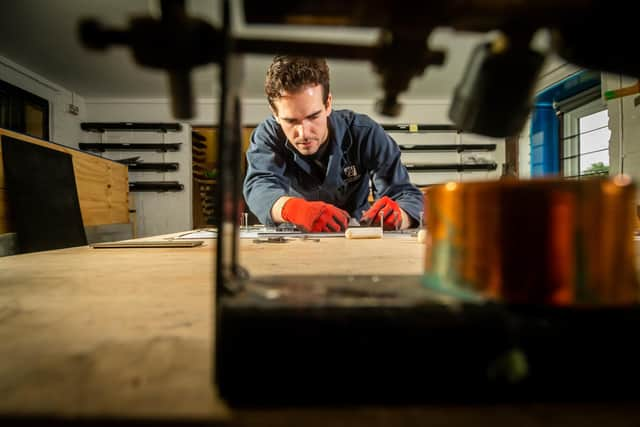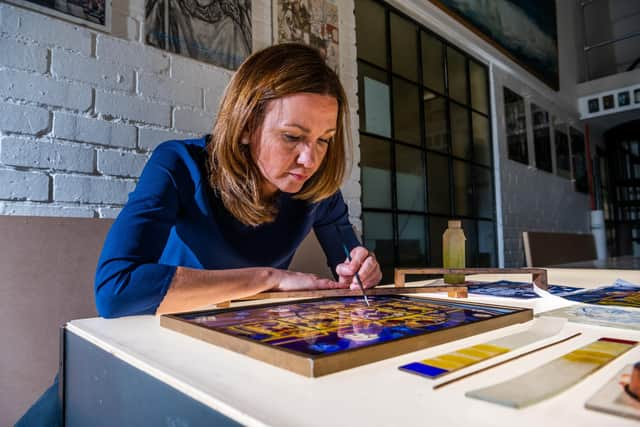Meet the Yorkshire stained glass window experts keeping an ancient craft alive
Yet the stark reality is hands-on skills that have produced some of the world’s finest buildings and shaped our landscapes could be lost forever if the baton isn’t passed to the next generation.
That is certainly something Keith Barley and Helen Whittaker are conscious of as they go about their very important business at the internationally recognised Barley Studio in Dunnington, near York.
Advertisement
Hide AdAdvertisement
Hide AdInterestingly, it was with the then newly founded York Glaziers Trust (YGT) at York Minster where Keith served a four year apprenticeship after leaving school at 16.


“It hit all the right buttons as far as education was concerned. At school my subjects were anything but English Language – science, history and art,” explains Keith.
“My Mother was interested in church architecture and my Grandmother looked at gravestones. We used to visit churches in York. I was around at the right time in the right place.”
Following his education at an RAF Benevolent Fund School in London, his late father served in the RAF, Keith didn’t want to go into further education and came to York to serve his apprenticeship where he became absorbed in the subjects he’d enjoyed at school.
Advertisement
Hide AdAdvertisement
Hide Ad“Arts and crafts and technical drawing, everything I enjoyed at school, I practiced,” recalls Keith.


With a keen focus on stained glass windows as a work of art rather than an object of antiquity, and collaborating with historians nurtured Keith’s conservation interest which, along with restoration, is the foundation for the business he initially set up in his bedroom.
Expansion led to the purpose-built site Barley Studio now occupies where the 10-strong team work on domestic and high profile commissions.
Switching on the expansive light table, stained glass artist and Barley Studio director, Helen Whittaker, demonstrates how works in progress are illuminated beneath the gallery, accessed by a spiral staircase, where she can cast her critical eye over the piece-by-piece productions.
Advertisement
Hide AdAdvertisement
Hide AdTeam work is evident when meeting staff in the different departments at Barley Studio – which celebrates its 50th anniversary in September.
Interestingly, Daniel Thomas, who leads and installs windows, was seeking a career in IT before arriving here 21 years ago.
“I wanted to do IT but it was dull. We had a careers adviser back then and I said I wanted to do something creative with my hands,” he says.
During her 25 year career, Helen, whose love of art stems from her parents and her stepfather’s encouragement to pursue stained glass as a subject for further study, has been involved in some high profile collaborations.
Advertisement
Hide AdAdvertisement
Hide AdAfter graduating from her glass and ceramics course at Sunderland University, Helen embarked on the Visual Islamic and Traditional Arts course run by The Prince’s Foundation School of Architecture.
“It was a two year masters course headed by an incredible chap, Professor Keith Critchlow,” recalls Helen.
Professor Critchlow is one of many influential role models Helen has met throughout a career which has introduced her to Royalty and led to collaborations with some of the world’s greatest artists.
On graduating from The Prince’s Foundation School of Traditional Crafts, Helen’s stained glass translation of The Divine Geometer, a Medieval manuscript, caught the attention of the then Prince of Wales, now King Charles III who, she recalls, purchased one of her works.
Advertisement
Hide AdAdvertisement
Hide Ad“It was amazing. He is such a promoter of the traditional arts and crafts and to buy something at my degree show was incredible,” says Helen, who re-joined Barley Studio, where she had worked as an apprentice and on placement, after her studies.
One of her early commissions was for five stained glass windows at the Haven Trust in Fulham.
Currently, she is working on a commission for the “London Pavilion” of “Art Macao: Macao International Art Biennale 2023.”
Helen’s designs also adorn some of the Capital’s iconic buildings including Westminster Abbey, where she collaborated on commemorative windows with fine artist, Hughie O’Donoghue RA and Bradford-born David Hockney RA.
Advertisement
Hide AdAdvertisement
Hide AdHelen interpreted Hughie’s design into two Marian windows installed by Barley Studio in the Henry VII Chapel to commemorate the 60th anniversary of the late Queen Elizabeth II’s Coronation.
In 2018, Helen worked with David Hockney on ‘The Queen’s Window,’ commissioned to celebrate the reign of the late Queen Elizabeth II.
Themed on a country scene, the design reflects the Queen’s love of the countryside.
“I was blown away – I got a phone call asking if I could go to California and work with him for four days,” recalls Helen.
Advertisement
Hide AdAdvertisement
Hide Ad“He is so down to earth and extremely learned. I really admired his artistry. It was so nice to be around such a positive energy. I felt so inspired and uplifted by him and his team.”
Southwell Minster in Nottinghamshire was another high profile project.
Helen explains Keith’s collaboration with architect Martin Stancliffe and artist Patrick Reyntiens to create a new West Window for the Minster, led to the them creating 16 new windows for the North and South transepts.
The project brought a new dimension to the studio which, since the Seventies, had been concerned with conserving.
Advertisement
Hide AdAdvertisement
Hide AdAmong the studio’s latest developments is the internally ventilated environmentally protective glazing for stained glass.
“He (Keith) felt we could learn so much from the past which would infuse the future,” says Helen.
Closer to home, her involvement in a project at St John’s Church in Beverley led her to develop her metalwork skills – another creative string to her bow demonstrated through her sculptural designs.
“I came up with a whole theme of sculptured figures in copper design, kneelers, benches and candle stands – objects to go with the stained glass windows. I felt there needed to be movement within the space rather than just looking at the window,” explains Helen, who worked alongside her mentor, York sculptor, Harold Gosney, on the project.
Advertisement
Hide AdAdvertisement
Hide AdOne of their largest ecclesiastical assignments was conserving 28 storm damaged windows at St Mary’s Church, Fairford, Gloucestershire.
“It wasn’t just about conserving, it was the narrative. They are beautiful because of the colours, but there is a story in there. They are a living object,” says Helen, who taught and gives talks about her work.
Educating others is imperative to the craft’s survival. Through their involvement with the Worshipful Company of Glaziers and Painters of Glass, of which Keith is also a past master, Helen helps to run a competition encouraging designs from budding stained glass designers.
They believe lack of demand from church closures, and fewer courses on the subject, could threaten the industry’s survival.
Advertisement
Hide AdAdvertisement
Hide Ad“We have been teaching people from all over the world,” says Keith, who received an MBE for Services to Cultural Heritage.
“It’s the history, the meaning in these works and I just like working with my hands and solving problems.”
This year stained glass window making (historic) has been added to the Red List of Endangered Crafts compiled by Heritage Crafts.
Launched in 2017, the list - funded by The Pilgrim Trust with additional sponsorship from The Royal Mint - raises awareness of crafts at risk of dying out in the next generation including those with very few practitioners, few (if any) trainees and a lack of viable training routes by which skills can be passed on.
Advertisement
Hide AdAdvertisement
Hide AdEndangered Crafts Manager, Mary Lewis, says stained glass windows (historic) was added to the list due to concerns from the British Society of Master Glass Painters who are set to lose 41 per cent of their skilled practitioners in a decade due to retirement.
“They will change and they will evolve. New skills will develop, it’s just not throwing the baby out with the bathwater, and making sure that hand skills can exist. We think that hand skills can exist alongside digital skills,” says Mary.
For more information visit www.barleystudio.co.uk; www.redlist.heritagecrafts.org.uk.